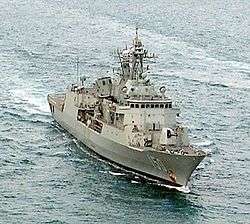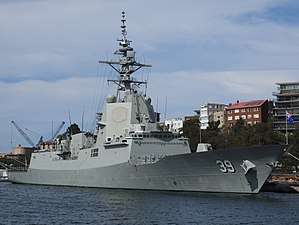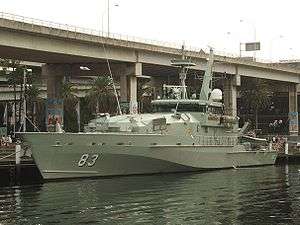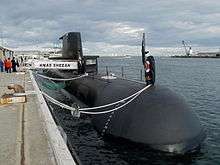Future of the Royal Australian Navy
The Royal Australian Navy, although a significant force in the Asia-Pacific region, is nonetheless classed as a medium-sized navy. Its fleet is based around two main types of surface combatant, with limited global deployment and air power capability. However, in 2009, a white paper, Defending Australia in the Asia Pacific Century: Force 2030, was produced by the Australian government which set out a programme of defence spending that will see significant improvements to the RAN's fleet and capabilities.
Ships under construction
The following is a list of vessels currently under construction for the Royal Australian Navy:[1]
| Class | Ship | Pennant No. | Builder | Displacement | Type | Commissioning | Status |
|---|---|---|---|---|---|---|---|
| Supply-class replenishment oiler | Supply | A195 | Navantia, Ferrol | 19,500 tonnes | Auxiliary oiler replenishment | 2020 | Sea Trials |
| Stalwart | A304 | 2022 | Launched | ||||
| Arafura-class offshore patrol vessel | Arafura | ASC, Osborne | 1,640 tonnes | Offshore patrol vessel | 2021 | Keel laid | |
| Eyre | 2022 | Keel laid | |||||
| Pilbara | Civmec, Henderson | 2023 | Under Construction |
Surface combatants
Anzac-class frigate

The Anzac class is the latest major fleet type to enter service. The first unit was commissioned in 1996 and the last entered service in 2006. Starting in November 2003, all eight frigates underwent extensive upgrades under Project SEA 1448 Phase 2, the Anzac Ship Anti-Ship Missile Defence upgrade. Completed in two phases, the following systems were upgraded and installed:
- Upgrade to the Saab Systems 9LV 453 Combat Management System.
- Installation of a SAGEM Vampir NG Infra-Red Search and Track System capable of detecting anti-missile and low-flying aircraft near land.
- Installation of an Australian CEAFAR S-band phased array radar and CEAMOUNT X-band multi-channel phased array missile illuminator to deliver enhanced target detection and better tracking, allowing Evolved Sea Sparrow missiles to engage multiple targets simultaneously.
- Installation of an I-Band navigation radar to replace existing target indication and Krupp Atlas 9600 radar systems.
Final Operating Capability is scheduled for October 2017.[2][3][4] The vessels are expected to remain in service until 2032 where they will be replaced with up to nine frigates designed primarily for anti-submarine warfare.[5]
Hobart-class air warfare destroyer

The most significant project currently under construction for the RAN are three Hobart-class air warfare destroyers under construction in Adelaide, South Australia to replace the Adelaide-class frigates. Although the 2009 Defence White Paper and original contract suggested that a fourth ship may be ordered, the 2016 Defence White Paper concluded that only three would be built. Each destroyer will be fitted with the Aegis combat system and will be based on the F100 design by Spanish shipbuilding company Navantia. Each vessel will be fitted with cruise missiles and the SM-6 anti-aircraft missile. Hobart was commissioned on 23 September 2017, with the following vessels to be delivered in 2018 and 2019. The destroyers are being built by ASC Pty Ltd, although the project involves a significant amount of work sub-contracted to other companies and locations.[6] The destroyers are to be named Hobart, Brisbane and Sydney.
Hunter-class frigate
With the Anzac-class frigates due to begin retiring in the late 2020s, work on a replacement program has begun. The program is expected to cost AU$35 billion and a request for tender for the vessel design was released in March 2017 to three contenders: Navantia, Fincantieri, and BAE Systems as part of a competitive evaluation process. In June 2018, Prime Minister Malcolm Turnbull announced that a variation of the BAE design had been selected as the preferred tender for the Hunter-class frigates.[7] Construction will begin in Adelaide, South Australia in 2020.[8] Australian shipbuilding company ASC will become a subsidiary of BAE Systems Australia for the duration of the build.[9]
Amphibious warfare

The RAN's amphibious capabilities was greatly increased by a new class of two Canberra-class amphibious vessels. These ships, based on Navantia's Strategic Projection Ship (later commissioned into the Spanish Navy as Spanish ship Juan Carlos I), displace approximately 27,000 tonnes, can transport 1,000 personnel and 150 vehicles, and can transport these ashore through landing craft carried in a well deck, or helicopters, with up to six operating simultaneously from each ship's flight deck. The new ships, named HMAS Canberra and HMAS Adelaide, their hulls were built at Navantia's shipyard in Spain, then transported to BAE Systems Australia (BAE acquired Tenix Defence after contract awarded) facilities at Williamstown, Victoria for finishing. The two ships replaced the Kanimbla-class amphibious vessels. HMAS Tobruk was to be replaced by a strategic sealift vessel of 10,000 to 15,000 tons displacement, which will provides the capacity to transport equipment, supplies, helicopters, and soldiers into zones of operation, and embark or disembark these without port facilities. .In the 2016 defence white paper it revealed that HMAS Choules would fulfill this role. Following the early decommissioning of both Kanimblas and Tobruk being out of action, multiple ships were purchased and or leased to cover the lack of amphibious capability. The RAN planned also replace the six Balikpapan-class heavy landing craft with six larger vessels. In mid-2011, the RAN acquired the former British Royal Fleet Auxiliary landing ship RFA Largs Bay, which entered service in December 2011 as HMAS Choules.
Minor vessels

Between 1999 and 2003, the RAN acquired six Huon-class minehunters.[10] Based on Intermarine SpA's Gaeta-class minehunters, each ship is equipped with a variable depth sonar, and a pair of Bofors Double Eagle underwater clearance vehicles.[10]
Up to the turn of the 21st century, the RAN's main patrol force was made up of the Fremantle class. However, these have been replaced by the new Armidale class. The first of these, HMAS Armidale, was commissioned in June 2005, and was the first of fourteen. These vessels are significantly more capable than the Fremantle class, and better equipped for a greater range of sea conditions.
The 2009 Defence White Paper announced that a new class of 20 offshore combatant vessels would replace the Armidale and Huon classes, along with the Leeuwin and Paluma-class survey ships.[11] The multi-role ships are predicted to displace anywhere up to 2,000 tonnes, and may be equipped with a helicopter or unmanned aerial vehicle.[11] However the 2016 Defense White Paper decreased the amount of planned vessels to twelve and stated that they would only replace the Armidales while the other classes would see life-extension work. Lurssen's OPV 80 design was chosen. The class was named Arafura-class offshore patrol vessel (OPV). The first ship will be named Arafura.
During the 2019 election campaign, Scott Morrison announced that one hydrographic survey ship and two minehunters would be constructed from the mid 2020s in the Henderson Shipyard Precinct Under SEA 1905 and SEA 2400. SEA 2400 Hyrdographic Data Collection Capability Program which includes the introduction of a Strategic Military Survey Capability(SMSB) to replace the Leeuwin-class survey vessels. While SEA 1905 is the acquisition of a further 2 Arafura-class offshore patrol vessels in a mine counter-measures configuration.[12][13] This was expanded in the 2020 Defence Strategic Update and 2020 Force Structure Plan released on the 30 June 2020 for up to 8 vessels optimised for mine countermeasures and hydrographic survey roles potentially based on the Arafura design.
The Government announced that 6 evolved Cape class patrol boats from Austal to be built in Henderson, Western Australia will be acquired for A$350 million on 1 May 2020 to with deliveries expected to start from September 2021 to mid-2023 to boost patrol capability. [14]
Submarines

The Collins-class submarines, the first of which entered service in 1996, are due to receive a major upgrade to their combat systems, with technology based on the US Navy's Virginia class. This new system will be introduced in conjunction with the new heavyweight torpedo.
In the longer term, the Collins-class submarines will begin to reach the end of their useful life in 2026.[15] To meet an in-service date of 2026, advanced design work on the next generation of Australian submarines will begin by 2014–2015. The submarines are likely to be Australian-built, conventional submarines equipped with air independent propulsion and advanced combat and communications systems.[16] Defence Minister Joel Fitzgibbon ordered planning to begin on the next generation of submarines to replace the Royal Australian Navy's Collins-class fleet. The 17-year project will be the largest, longest and most expensive defence acquisition since Australia's Federation, potentially costing up to $25 billion. The submarines are expected to be capable of carrying long-range cruise missiles and midget-subs.[17]
According to the 2009 Defence White Paper, the submarine fleet is to be expanded to 12. The submarines will be equipped with cruise missiles and the world's most advanced torpedoes, sonars, combat systems, intelligence gathering systems as well as also being able to support special forces operations. The first submarine is expected to be in service by 2030 with the decommissioning of HMAS Collins. The 2009 White Paper predicted the cost of the new submarines at $35 billion.
In 2018, Naval Group's Shortfin Barracuda design was chosen as the design for the new vessels. It was announced that these vessels would be designated the Attack-class submarine with the first vessel being named HMAS Attack.
Afloat Support
The RAN currently has two ships used for afloat support/replenishment at sea; HMAS Sirius is a fleet oiler, with a limited dry stores capability, while HMAS Success is a general dry stores/fuel replenishment vessel. The navy has initiated a project that will ultimately see two new purpose built vessels enter service by 2020. Sirius was purchased second hand (double hulled to meet new international regulations) in 2005 as MT Delos and converted to replace HMAS Westralia in 2006. Then, as Sirius reaches the end of its service life around 2018, a new vessel will be purpose built. At around the same time (approximately 2015), a replacement for Success will be constructed.
The Minister of Defence confirmed in March 2016 that Navantia had been selected to build the next two replenishment vessels. The project is expected to cost anywhere between $1 and $2 billion. Navantia had offered Australia a design based on the Spanish Navy's current replenishment vessel Cantabria, which entered service in 2011.[18] The ships will be named HMAS Supply and HMAS Stalwart.[19] Supply was launched at Ferrol on 23 November 2018.[20]
Fleet Air Arm
The Fleet Air Arm is currently an all rotary winged organisation. Previously 16 S-70B-2 Seahawks helicopters were the combat helicopters of the Air Arm. The Seahawks were being upgraded with FLIR and enhanced ECM, to improve both their surveillance and self-defence capabilities. In the 2009 Defence White Paper the Australian Government stated that it will urgently acquire at least 24 new naval combat helicopters.[21]
The Navy's Sea Kings, which had been in service for twenty years, werebe replaced by MRH 90 helicopters modified for naval purposes by 2010. These aircraft were purchased as part a joint Army-Navy helicopter purchase.[22] All 6 have been delivered.
The 2009 Defence White Paper, Defending Australia in the Asia Pacific Century: Force 2030, stated that the RAN needed to replace its 16 Seahawk helicopters with at least 24 new helicopters by 2014. In June 2011 the Australian government announced the purchase of 24 MH-60R "Romeo" Seahawk helicopters as a replacement for the S-70-B2. All 24 have been delivered.
List of major projects
(Updated to reflect changes made in the Defence Capability Plan – June 2011 Supplement)
- JP 2048 – Amphibious Deployment and Sustainment program
- Phase 5: Balikpapan-class landing craft replacement – 6 new LCH design
- RFI assessment completed. RFP to be issued early 2012.[23]
- As of 2019 no further developments.
- Phase 5: Balikpapan-class landing craft replacement – 6 new LCH design
- Sea 1000 – Design and Procurement of Future Submarine
- Phase 1 & 2: Phase 1 (Design) and Phase 2 (Acquisition) has been combined. Decision not due until 2017–2020 or so.
- Sea 1180 – Arafura-class offshore patrol vessel.
- Sea 1360 – Maritime Extended Range Air Defence (Standard SM-6 for Hobart-class destroyer)
- Phase 1: Project definition stage. Budget for capability reduced from $1–$2b to $500m-$1b.
- Sea 1439 – Installation of new combat system for Collins-class submarines
- Phase 4A: Replacement Combat System.
- Currently underway, IOC has been achieved and FOC expected by 2013.
- Replacement system is the same AN/BYG-1v8 system fitted to the Virginia-class SSN.
- Phase 4B: Weapon & Sensor Enhancements.
- Currently underway.
- Phase 6: Sonar Replacement.
- Given first-pass approval.
- Phase 4A: Replacement Combat System.
- Sea 1448 – Anzac-class frigate capability upgrades
- Phase 2B: Anzac-class Anti-Ship Missile Defence upgrade
- HMAS Perth successfully completed trials of ASMD upgrade in July 2011.
- The upgrade of the other seven Anzac-class frigates has been given government approval.[24] The upgrade is due to begin early 2012 and be complete by 2017.
- Phase 4A: ES system improvement given first-pass approval.
- Phase 4B: AN/SPS-49 (Air Search Radar) replacement budget increased from $100–$300m to $300–$500m.
- RFI released.
- Phase 2B: Anzac-class Anti-Ship Missile Defence upgrade
- Sea 1654 – Maritime Operational Support Capability
- Phase 3: HMAS Success replacement
- Keel laid for NUSHIP Supply on 18 November 2017, construction expected to be complete by 2020
- Phase 3: HMAS Success replacement
- Sea 5000 – Future Frigate Program – (Anzac-class frigate replacement)
- Phase 1: Project definition stage. Contract awarded to BAE Systems Australia June 2018, 9 ships to enter service 2027 - 2042[25]
- SEA 1905 is the acquisition of a further 2 Arafura-class offshore patrol vessels in a mine counter-measures configuration.[12]
- SEA 2400 Hyrdographic Data Collection Capability Program which includes the introduction of a Strategic Military Survey Capability(SMSB) to replace the Leeuwin-class survey vessels.[12]
A full listing of all current Projects is available at the Defence Materiel Organisation website.
Recently completed projects
Notes
- "Future fleet oilers named". Navy Daily. Department of Defence (Australia). 17 November 2017. Retrieved 18 November 2017.
- "Anzac Ship Anti-Ship Missile Defence". Department of Defence (Australia). December 2014. Retrieved 16 May 2017.
- Rahmat, Ridzwan (18 August 2016). "ANZAC frigate HMAS Toowoomba begins anti-ship missile defence upgrades". IHS Jane's 360. Archived from the original on 19 August 2016. Retrieved 16 May 2017.
- "Anzac Ship Anti-Ship Missile Defence". Department of Defence (Australia). December 2014. Retrieved 16 May 2017.
- "Anzac Class Frigate". Department of Defence (Australia). December 2014. Retrieved 16 May 2017.
- Navy unveils $11b warship contract, Australian Broadcasting Corporation. Retrieved 20 June 2007.
- Taylor, Rob (28 June 2018). "Australia's $26 Billion Warship Deal Goes to Britain's BAE". The Wall Street Journal. Canberra, Australia. Retrieved 28 June 2018.
- "Future Frigate". Department of Defence (Australia). September 2016. Retrieved 16 May 2017.
- Tillett, Andrew (28 June 2018). "Rule Britannia as Malcolm Turnbull chooses UK design for $35b frigate contract". Australian Financial Review. Retrieved 28 June 2018.
- Saunders, Stephen, ed. (2008). Jane's Fighting Ships 2008–2009. Jane's Fighting Ships (111th ed.). Surrey: Jane's Information Group. p. 32. ISBN 978-0-7106-2845-9. OCLC 225431774.
- Department of Defence (2 May 2009). Defending Australia in the Asia Pacific Century: Force 2030. Commonwealth of Australia. pp. 72–3. ISBN 978-0-642-29702-0. OCLC 426475923.
- "Draft Strategic Infrastructure & Land Use Plan" (PDF). Western Australian Government. 18 June 2020.
- "Navy warships to be built in Perth under Coalition election pledge worth $1b". www.abc.net.au. 29 April 2019. Retrieved 30 June 2020.
- https://www.defenceconnect.com.au/key-enablers/6023-navy-to-get-new-patrol-boats-to-boost-capability
- "Australia's Future Underwater Warfare Capability – Project SM 2020". Submarine Institute of Australia. Archived from the original on 20 August 2006. Retrieved 17 September 2006.
- Patrick Walters (2006). Cutting Edge: The Collins experance. Australian Security Policy Institute, Canberra. Pages 10–11.
- Stuart, Cameron (26 December 2007). "Navy to get new lethal submarine fleet". The Australian. Archived from the original on 26 December 2007.
- Grevatt, Jon (10 March 2016). "Australia selects Navantia for new replenishment ship". IHS Jane's 360. Archived from the original on 13 March 2016. Retrieved 4 December 2018.
- Dominguez, Gabriel (17 November 2017). "Australia names future replenishment vessels". IHS Jane's 360. Retrieved 19 November 2017.
- Rahmat, Ridzwan (26 November 2018). "Navantia launches Australia's first replenishment vessel, begins work on second". Janes360. IHS Markit. Retrieved 4 December 2018.
- Australian Government Defence White Paper 2009 page: 72
- Archived 27 August 2006 at the Wayback Machine
- Brown, Phill (30 June 2011). "Amphibious Deployment & Sustainment Program" (PDF). Archived from the original (PDF) on 27 February 2012. Retrieved 16 August 2011.
- Clare, Jason (28 November 2011). "New Cutting Edge Missile Defence System for ANZAC Ships". Department of Defence. Archived from the original on 27 February 2012. Retrieved 28 November 2011.
- Here comes the Hunter: BAE awarded $35bn SEA 5000 Future Frigate Contract Defence Connect 28 June 2018